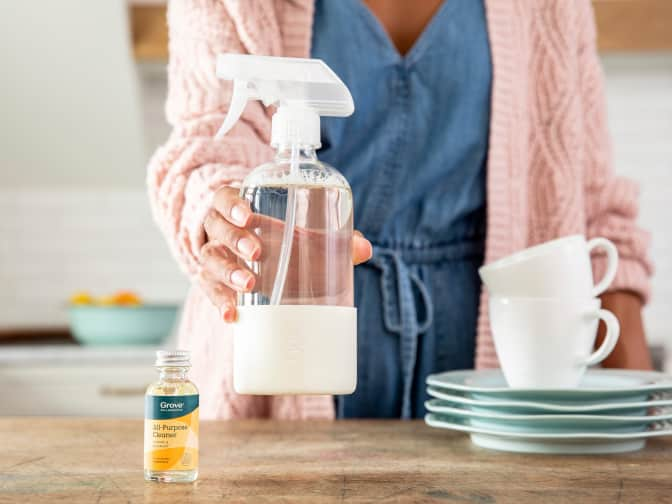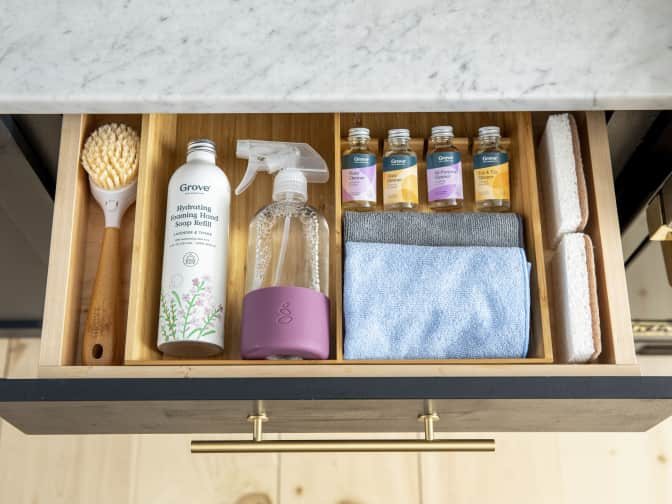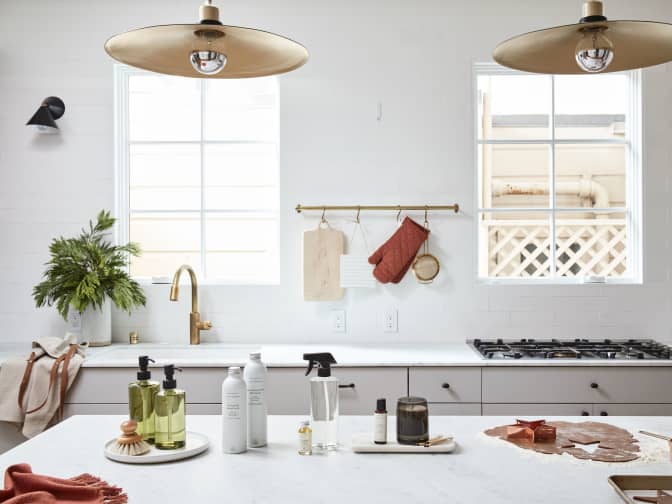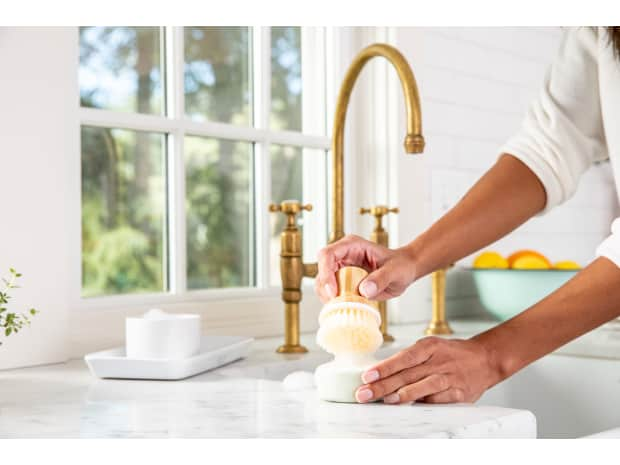
Let the surface cool
Make sure your stove is off and the top is cool to the touch before you clean it. Cleaning a hot stove top is a sure-fire way to get yourself burned, ruin your sponge or microfiber, and suffer from serious streaking.


Last Updated: March 15, 2021
Keep your fancy glass stove top clean and streak-free (and avoid damaging it!) with these best practices.

Ready to tackle the dirtiest spots in your home? Grove Collaborative has you covered with Clean Team. Each week, we’ll do a deep dive into how to clean a different place or item in your home. No spot is too small — and we’ll tell you how to conquer them all, naturally.
Lead image by Leah Flores
Glass-top stoves are popular for their sleek surfaces that make your kitchen look fresh, clean, and modern. They can double as extra counter space when not in use, and clean-up is a cinch, since they don’t have grates like gas or electric stoves. If you’ve got a flat-top stove and you’re wondering how to best clean it and prevent streaks, residue, and gunky build-up, wonder no more. Here’s our expert guide on how to clean a glass stove top quickly and efficiently — and without gross chemicals.

Glass stove tops require a different kind of care than electric or gas stoves. Glass flat tops are made from a glass-ceramic blend, which can scratch more easily than other types of stoves. It’s also prone to streaking, which is the bane of many glass stove owners’ existences. Cleaning your glass stove regularly will prevent spills and cooking residue from accumulating into tough, burnt-on stains. And cleaning it properly will keep those streaks at bay so your cooktop looks as clean as it is.

Some glass-stove manufacturers offer specific cleaning instructions, including what products and tools to use, so read the instruction manual before you pull out your cleaning supplies. If you no longer have the instructions, you can probably find them online — or trust that this guide won’t steer you wrong, no matter who manufactured your stove.Here are some general rules of thumb when cleaning your glass stovetop.

Make sure your stove is off and the top is cool to the touch before you clean it. Cleaning a hot stove top is a sure-fire way to get yourself burned, ruin your sponge or microfiber, and suffer from serious streaking.

Harsh abrasive cleansers will scratch your glass stovetop, so it’s best to avoid them like the plague. Vinegar and baking soda are powerful enough to get your stove clean while being gentle enough to use without leaving marks.

Scouring pads, steel wool, and scrub brushes are a bit too intense for your glass stove top. Reserve those for that pan you cooked lasagna in a week ago, and use sponges or microfiber cloths on your glass stove top.
Using a glass cleaner on your glass stove sounds like a no-brainer, but it’s actually a terrible idea. Most conventional glass cleaners contain ammonia, a harsh chemical that’s too strong for glass top stoves and will leave streaks and stains that won’t come off, no matter how hard you try. Reach for the white vinegar instead.
You can use just about anything to clean a conventional stove without damaging it, but not so with glass stove tops. These are a few things you should keep off your glass stove top whenever possible — and when it’s not, be very, very careful.
Avoid using cast iron, stoneware, or ceramic pots on glass stovetops. Since these materials tend to be heavy and rough, they could scratch your stove. If you must use them, set them down gently, and whatever you do, don’t drag them across the surface.
Obviously, you’re going to spill stuff on your glass stove — it’s unavoidable, unless you’re a perfect being who never spills anything, ever. But the longer you leave spills on your glass stovetop, the harder they’re going to be to get off.
Never put anything other than cookware on your glass stove. Utensils left on top of your stove can melt, making a huge bummer of a mess, or they can scratch the surface. Place a spoon rest to the side of your stove, where you can rest your cooking utensils.

Cleaning stubborn stains off of a glass cooktop without scratches or streaks requires just a few simple ingredients and tools that you’ve probably got under your sink at this very moment. Whether you’re a daily cleaner or a once-a-month deep cleaner — or both — we’ve got options for you.

Wiping down your stovetop every day — ideally after every use — is the best way to keep it clean and stain-free. Keep your stove cleaning supplies close at hand to make daily wipe-downs easy.
What you’ll need:
Spritz your stovetop with the vinegar, and wipe it down with a microfiber cloth. Use a dry microfiber cloth to buff out any streaks.
Life is busy, and it’s not always realistic to carve out time after every use to clean your stovetop, especially if you cook on it multiple times a day. If you’ve let the spills accumulate for too long, a good, deep clean is just what you need.
Razor blade method
Razor blades are a great way to remove hardened gunk from your glass stovetop — if you’re super-duper careful. Read your stove’s user manual first, and make sure it’s okay to use a razor blade on your model.
What you’ll need:
Spray the vinegar on any stains then hold the blade as flat as you can so that it’s nearly flush against the surface. Lightly scrape the stains off and wipe the surface clean with a microfiber cloth. Repeat this process as necessary until all residue is removed.
Soak method
If you can’t use a razor blade on your stove, try this method instead. It gives an excellent deep clean and requires less elbow grease than using a razor blade.
What you’ll need:
Mix about three parts baking soda to one part water to form a paste. With a gloved or bare hand, slather the mixture across your stovetop. Wet your microfiber cloths under hot water, wring them out, and lay them on top of the paste. Let the whole shebang sit for thirty minutes, then use the microfiber cloths to wipe off the paste. For reluctant stains, or if the paste is too hardened to easily remove, spray a bit of vinegar on the stove top, allow it to fizz, then wipe away.
Looking for more cleaning how-tos and other sustainable swaps you can make at home? Grove has you covered. From timely topics such as our handwashing and hand sanitizer breakdown to evergreen primers like our simple ways to reduce your plastic use at home, our handy guides are here to answer your most pressing questions. And let us know how if you have any cleaning questions (or share your own tips using #grovehome) by following Grove Collaborative on Instagram, Facebook, Twitter, and Pinterest.
If you're ready to take on dirty glass stove tops, shop Grove Collaborative's cleaning essentials for the cleaning tools to tackle the job.

Give your shower a deep clean with our easy tips on how to clean a shower head, an oft overlooked part of bathroom cleaning.

Discover the best tips on how to clean silver and ensure your items keep their shine and luster over time — no matter how often you use them.

Cleaning brass is admittedly not the most fun chore. But if you want brass that doesn’t look lackluster, you must clean it! So let’s talk brass.

We’ve put together a handy guide on how to clean travertine floors like a pro! Read on to ensure your floors stay clean and pristine.